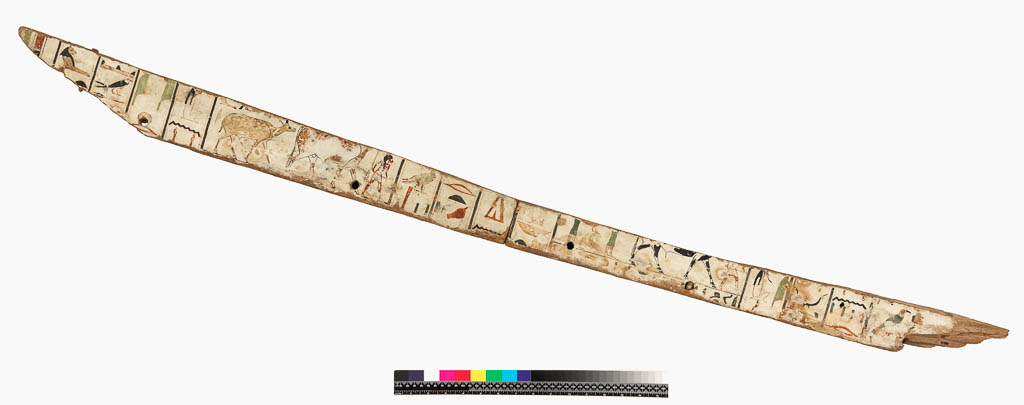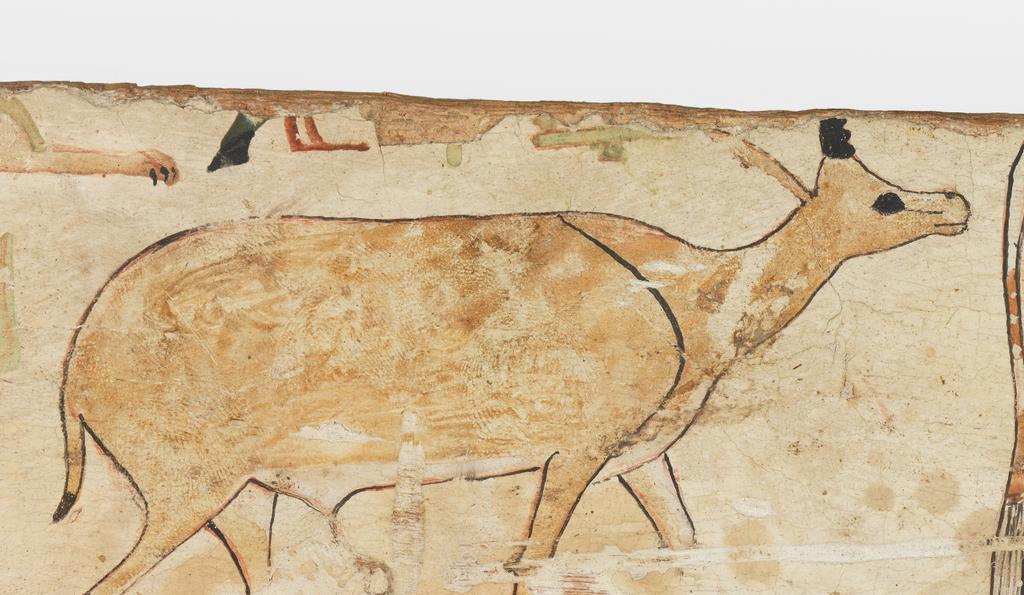

Object name: Fragment from the coffin of the master physician, Wepwawetemhat
Accession no.: E.W.66a
Other numbers and markings: “W.66” in ink
Dimensions: H 8.9 cm
W 3.4 cm
D 75.3 cm
Brief description:
Fragment from the proper left (east side) of the coffin of the master physician, Wepwawetemhat (meaning ‘Wepwawet is at the front’) showing a man dragging a cow with two standing women behind him.
With E.W.66b, these are two relatively small coffin boards. They present the remains of scenes in the middle and text columns at the sides. All hieroglyphs and figures are looking to the right. Both boards therefore come from the left (east) side of a coffin. On both fragments are always four text columns next to the scenes. The line on a belong to two hetep-di-n formula common on coffins found at Asyut: Htp di n ra-itmw Hna Drt.f (an offering given to Ra-Atum and his hand) and Htp di n gb Hna nwt (an offering given to Geb and Nut). The next column block seems to consist of imahy xr formulae including the name and title of the coffin owner.
The coffin owner has the name Wepwawetemhat, which was especially popular at Asyut in the Middle Kingdom. He bears the title ‘greatest of the physicians’. There are many coffins and coffin fragments known from Asyut, but only a few of them bear titles. Interestingly there is in the Museum of Tanta a coffin of a certain Wepay with the same title. Wepay might be the abbreviation of Wepwawetemhat and both coffins might belong to the same person. However, this is only a guess.
S 7 - imi-r aHa (overseer of ships) idi
S51 – imi-r pr (steward) Hny
S36ab – HAti-a imi-r Hmw-nTr (mayor, overseer of priests) msHti
S47a imi-r xtmt (treasurer) nxt
S47b imi-r aHa (overseer of ships), imi-r xwit (overseer of the chapel) nxt
S45, 46ab imi-r xtmt (treasurer) nxt
S24 wr swnw (master physician) WpAy
imi-r xtmt (treasurer) Wp-wAiwt-nxt
The coffin panel is made from a single piece of radially cut wood (sycomore fig), where the grain runs along the length. There are five dowel holes, one with a deformed dowel surviving. Dowels would have been used to connect separate planks together to form the coffin. As is common with coffins of this type, there are four columns of text next to the scenes, including two hetep-di-nswt formulas.
The external face of the panel is coated with a white preparation layer (this was observed under PLM and thought to be calcite from ground limestone), which is used as a background to the hieroglyphs and figures. A red under-drawing is visible in places. A faint red outline of the cow’s front proper left leg is visible adjacent to its finished position indicating an alteration to the drawing. This and other pigments were also examined with PLM to attempt identification, though the results are yet to be confirmed by other analytical techniques (XRF or FORS). The reds show characteristics that are compatible with cinnabar, while the green pigment particles resemble Egyptian Green. Where it is thickly applied, the black paint shows brush marks. The pigment particles are very fine, and likely to be soot. The blues have been identified as Egyptian Blue using VIL. The yellow pigment is likely to be a mixture of calcite and orpiment. The blue feathers and black outlining on the bird on the far proper left overlie the yellow face colour.
The back and long sides of the plank are patchily coated with a white and yellow-brown ground. There are also areas of possible animal glue. These sides were probably adhered to other planks with this material alongside the dowels.
This fragment joins with
Date: c. 1975-1790 BC
Middle Kingdom
Find spot: Most likely Asyut
Acquisition: Unknown (the piece reached the museum before 1957)
Construction, decoration and materials:
Other information

Coffin fragment of Wepwawetemhat, with E.W.66b. These fragments come from the bottom edge of the long side of the coffin box

Coffin fragment of Wepwawetemhat detail that shows fingerprints of the coffin maker when he probably coloured the coffin